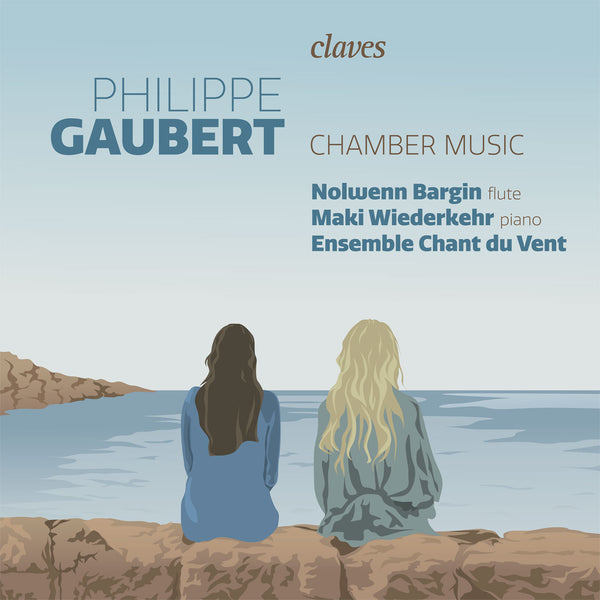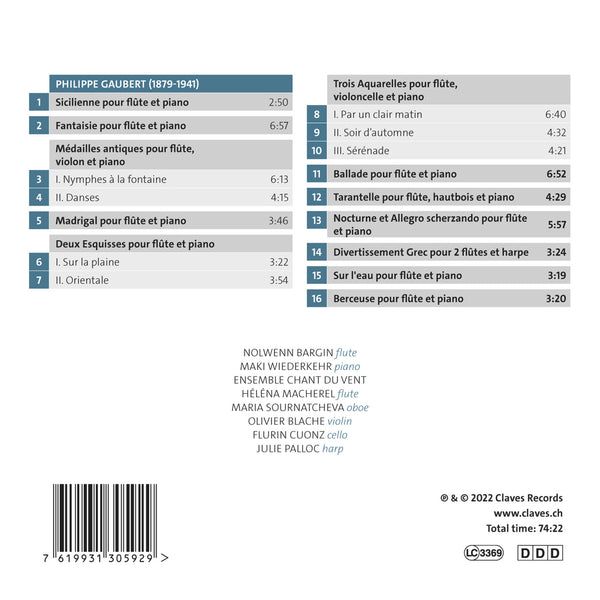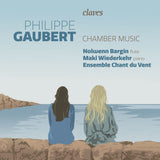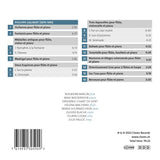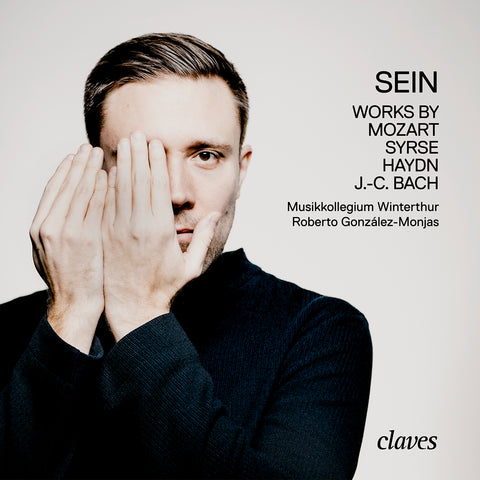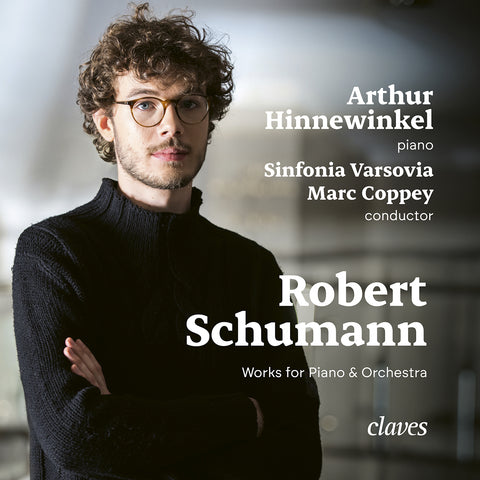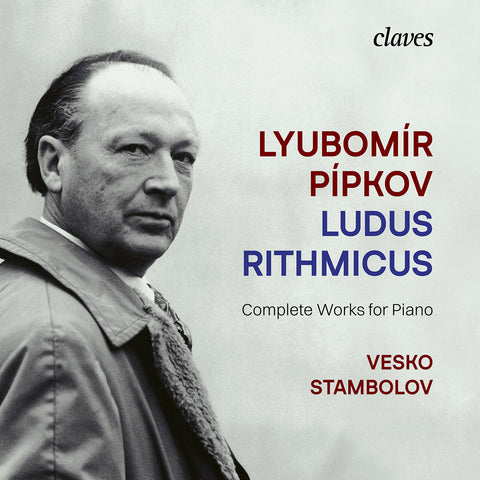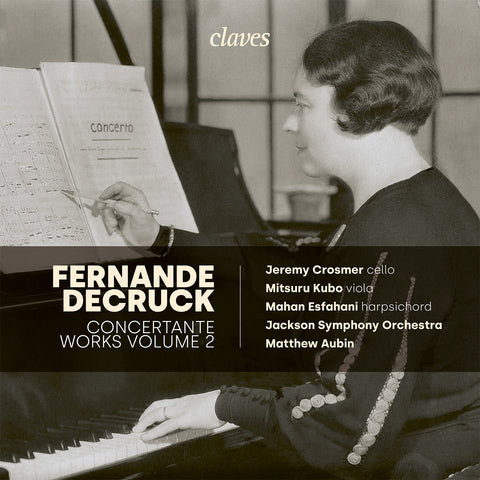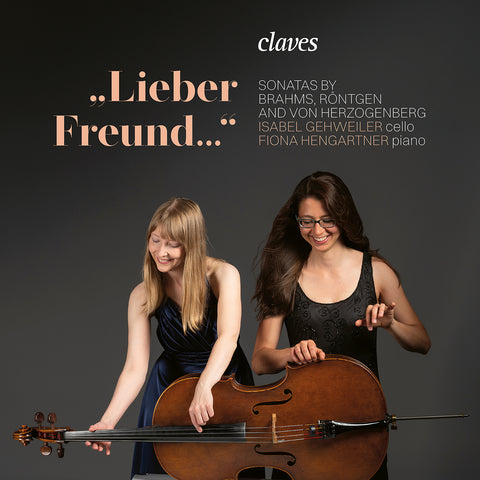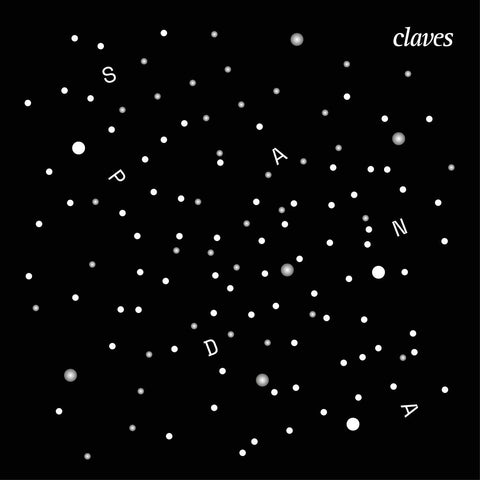(2022) Philippe Gaubert, Chamber Music
Category(ies): Chamber Piano Rarities
Instrument(s): Cello Flute Harp Oboe Piano Violin
Main Composer: Philippe Gaubert
Ensemble: Ensemble Chant du Vent
CD set: 1
Catalog N°:
CD 3059
Release: 25.11.2022
EAN/UPC: 7619931305929
This album is now on repressing. Pre-order it at a special price now.
CHF 18.50
This album is no longer available on CD.
This album has not been released yet. Pre-order it from now.
CHF 18.50
This album is no longer available on CD.
CHF 18.50
VAT included for Switzerland & UE
Free shipping
This album is no longer available on CD.
VAT included for Switzerland & UE
Free shipping
This album is now on repressing. Pre-order it at a special price now.
CHF 18.50
This album is no longer available on CD.
This album has not been released yet.
Pre-order it at a special price now.
CHF 18.50
This album is no longer available on CD.
CHF 18.50
This album is no longer available on CD.
PHILIPPE GAUBERT, CHAMBER MUSIC
PHILIPPE GAUBERT CHAMBER MUSIC
Those playing the flute may know Philippe Gaubert as co-author of the great Méthode complète de flûte, a standard work even a hundred years after its publication. Those who do not play the flute have in all likelihood never heard of him - yet Gaubert was an outstanding figure in French musical life in his day and is still highly interesting as a composer today.
The eventful life of a multi-talent
Born in 1879 in the Occitan town of Cahors, Philippe Gaubert moved with his family to Paris as a child, where he received private flute lessons at an early age from the great Paul Taffanel. At the age of fourteen he was officially admitted to the Conservatoire, and at eighteen he became principal flute at the Paris Opéra and an orchestral member of the venerable Société des Concerts du Conservatoire, where he was elected assistant conductor in 1904. In 1905 he ranked second in the Prix de Rome, the composition competition par excellence.
During World War I, Gaubert served as an infantryman, forcing him to put his musical activities aside.
Then, in 1919/20, he was offered three positions almost simultaneously, any one of which would have been enough to secure him a place in musical Parnassus: chief conductor at the Opéra, chief conductor at the Société des Concerts du Conservatoire, and professor for flute at the Conservatoire. Gaubert accepted them all, ending his soloist career at its peak and henceforth acting as one of the most influential figures in the musical life of Paris.
After his sudden death in 1941, obituaries across the country paid tribute to the great conductor and flutist; as a composer, he garnered little attention even at the time. Yet Gaubert’s OEuvre encompasses almost all genres: One constant in his oeuvre is, of course, the flute, which he used in many combinations - only, astonishingly, he never dedicated a solo concerto to it. He also composed a large number of piano and orchestral songs; in later years he also composed a series of major orchestral works, two operas and three great ballets.
His style is characterized by a lyrical quality that always prioritizes the melodic line, coloring it with a rich harmony. As early as 1924, the music journalist Dominique Sordet attested to the “subtlety of expression” of Debussy, the “flowing grace” of Fauré, and “a certain poetic and passionate ardor” peculiar to Gaubert himself. Nolwenn Bargin and her fellow musicians reveal on the present CD the wide spectrum of chamber music that resulted from this.
Gondellied and Nymph Round Dance
The Sicilienne for flute and piano (1914), initially written for orchestra, is an example of the return to old forms that was in vogue at the time: With its swaying rhythm and simple, songlike melody, Gaubert mimics a Sicilian gondola song.
A virtuoso showpiece, Fantaisie for flute and piano (1912) is inspired by Gabriel Fauré’s 1898 work of the same name. Like the latter, it consists of a slow and a fast part, which demand all the tricks of the flute without tipping over into vain virtuosity. In Gaubert’s case, there is also an exotic introduction and a large cadenza.
Gaubert dedicated his Médailles antiques for flute, violin and piano (1916) to his violinist friend Fernand Luquin, perhaps with a view to a joint performance. Thus the two nymphs, flute and violin, enjoy themselves at the rippling fountain of the piano. And perhaps it is also their round dance, which in the second movement is sometimes elegant, sometimes lively, then again languorous. Gaubert artfully employs the various techniques of the violin - his second instrument - and skillfully plays with the tonal possibilities of the combination of violin and flute.
The Madrigal, an early work for flute and piano (1908), remains one of the most popular pieces from Gaubert’s pen. The work shares with the original Renaissance madrigals the rapid alternation between cantabile and agitated episodes, as well as a harmonic twist or two.
Composing with pen and brush
The fact that the art-historical term ‘Impressionism’ was also associated with the music of the same period was certainly due to the fact that the composers in this period liked to make allusions to paintings in the titles of their works. Claude Debussy provided the Estampes (‘Prints’) and two large series Images (‘Pictures’), and Philippe Gaubert also liked to draw on the vocabulary of the visual arts.
The title of Deux esquisses for flute and piano (1914) is a deliberate understatement and the accompanying music, to use Beethoven’s phrase, “more an expression of sensation than painting.” In Soir sur la plaine, the introductory theme - Debussy’s Faune sends his regards - gradually becomes a natural part of the musical fabric, while the Orientale expands conventional harmony with sounds from the Far East.
The Trois Aquarelles for flute, cello and piano (1915) - written at the front during World War I - is also a genuine little sonata, beyond the painting of a view, at least in terms of the sequence of movements. The atmosphere of departure of D’un clair matin is followed by the thoughtful intermezzo Soir d’automne, concluding with the somewhat lively Sérénade.
Lyrical and virtuosic
With the triple establishment of his career after the war, Gaubert shifted from brilliant salon pieces to the more prestigious format of the sonata. The Ballade for flute and piano (1926) finally returns to the format of the Fantaisie once again, allowing the flute to become the storyteller.
The 24-year-old Gaubert dedicated his first publication, the Tarentelle for flute, oboe, and piano (1903), to his longtime teacher Paul Taffanel. The virtuoso piece for the two woodwind instruments draws on the idea of the Neapolitan tarantella, but Gaubert’s own style is already well recognizable here. Also dedicated to Taffanel is Nocturne et Allegro scherzando for flute and piano (1906), a dreamy recital piece in the best Chopin tradition followed by a bouncing scherzo reminiscent of Schumann. Evidence of the work’s high demands, as well as its importance, is the fact that it was chosen by the Paris Conservatoire as a compulsory piece for the admission examinations in 1906.
With the Divertissement grec for two flutes and harp (1908) we once again return to idyllic Arcadia - signifying the ancient Greece of fauns, nymphs and archaic scales. Instead of the lyre, however, the harp is being strummed, and the crooning flutes are not made of reeds, but of metal.
Two miniatures for flute and piano that evoke quite different moods in the same 6/8 time signature conclude the journey across Gaubert’s chamber music oeuvre. In Sur l’eau (1909), the flute carries us over the rocking waves of the piano accompaniment; the Berceuse (1907), on the other hand, captivates with a simple melody full of intimacy.
As a pioneer of a new French school of flute playing, Philippe Gaubert knew the qualities of his instrument; his oeuvre paved the way for the flute from the tradition of Debussy and Fauré into the modern age. A composer who definitely deserved more respect!
Adrienne Walder
***
Nolwenn Bargin, flute
Maki Wiederkehr, piano
ENSEMBLE CHANT DU VENT
Héléna Macherel, flute
Maria Sournatcheva, oboe
Olivier Blache, violin
Flurin Cuonz, cello
Julie Palloc, harp
Read bios in the booklet
***
Teaser
REVIEWS
« [..] Tant de dévouement aux œuvres d’autrui avait fini par faire oublier que Gaubert était un admirable compositeur, dans la plus pure veine française, et pas seulement pour son instrument : la Symphonie, le Concert en fa, Le Chevalier et la Damoiselle, Le Cortège d’Amphitrite restent encore trop ignorés des chefs d’orchestre, mais Gaubert fut d’abord flûtiste et composa de merveilleuses œuvres pour son instrument, d’une invention délicieuse, d’un raffinement d’écriture capiteux. C’est dans ce corpus parfois visité au disque ces dernières années avec des bonheurs divers, que Nolwenn Bargin opère une sélection idéale, s’entourant de solistes qui lui permettent de graver aussi des cahiers autres que ceux mariant uniquement flûte et piano. [..] Introduction parfaite à un univers qui reste à découvrir. » - Jean-Charles Hoffelé, février 2023
« [..] Les amateurs de flûte seront enchantés par ce panorama qui se situe entre Fauré et Debussy et la modernité, d’autant plus qu’il est remarquablement servi par la virtuose franco-suisse d’origine bretonne Nolwenn Bargin, actuelle flûtiste solo à Winterthur, dont le lyrisme et la chaleur ne sont jamais pris en défaut. La pianiste suisse Maki Wiederkehr, qui enseigne au Conservatoire de Zürich, est une partenaire souple et racée. Les autres solistes, à l’apport occasionnel, répondent adéquatement à l’unité harmonique d’un projet qui se révèle attachant. Dans le répertoire de la flûte, Philippe Gaubert occupe une place importante. Le présent enregistrement en est une indiscutable confirmation. » - Jean Lacroix, janvier 2023
« [..] Mit beseeltem und fein artikuliertem Spiel bieten Nolwenn Bargin und ihre Mitstreiter einen Einblick in das Œuvre des hierzulande so gut wie unbekannten Franzosen. Die Flötistin überzeugt mit melodischem Wohlklang und perlender Virtuosität. Die geistreichen kammermusikalischen Schmuckstücke zeugen von Gauberts kompositorischer Einfallskraft und lassen seine Vorbilder erkennen lassen – außergewöhnlich originell oder besnders innovativ sind sie allerdings nicht. » - Antje Rößler, Februar 2023
« Wer sich nicht mit der Flöte beschäftigt, kennt ihn wohl kaum, Philippe Gaubert (1879-1941), den französischen Flöten-Professor, der mit seiner Position am Conservatoire wichtige Impulse zur Musik für Flöte gab. Nolwenn Bargin, Solo-Flötistin beim Musikkollegium Winterthur, ist das Herz und die Seele hinter dieser wunderbar charmanten CD, die ein starkes Schlaglicht auf Gauberts Flöten-Kammermusik wirft, inklusive Klaviertrio-Werken mit Geige, Oboe oder Cello. Sehr oft meint man, Debussy zu hören, und das ist auch ganz klar eine musikalische Heimat dieses Flötenkomponisten. Aber er greift durchaus weiter, zum einen zurück in die französische Romantik, etwa zu Fauré, aber auch darüber hinaus in die expressionistischen Klangsprachen. [..] » - Reinmar Wagner, September 2023
« Only occasionally (as in the ‘Fantaisie’) does Gaubert demand virtuosity of his interpreters. His love is for the sound of the flute, rather than for flamboyance. Nolwenn Bargin plays with consummate certainty of technique and great sensitivity throughout this rewarding and enjoyable album, while pianist Maki Wiederkehr is a sympathetic accompanist who displays excellent judgement. On some tracks, their work is supplemented by the contributions of various members of the Ensemble Chant du Vent: by the violin of Olivier Blache, the cello of Flurin Cuonz, the oboe of Maria Sournatcheva, the harp of Julie Palloc and the flute of Héléna Macherel. All concerned acquit themselves admirably. [..] » - Glyn Pursglove, January 2023
“[..] The interpretations on this new Claves album are consistently idiomatic and technically finished to perfection, despite the wide variety of instrumentalists. Interpretations that moreover testify to a fresh and open-minded view of these scores and are brought to life in a very imaginative way. Without a doubt, a handsome achievement. [..]” - Aart van der Wal, October 2022
“[..] The performers, primarily Nolwenn Bargin as flutist, have focused on character pieces, leaving out the three sonatas and one sonatina for flute that also exist. Nevertheless, here is a disc filled to the brim. The ensemble Chant du Vent, with its founder Bargin, operates in changing lineups as needed. On this, Nolwenn Bargin’s first CD, the small instrumentations down to three participants are in demand. It is understandable that she dedicates it to a great representative of her flute guild and his works. Together with the colleagues she has found in her environment in Switzerland, they offer a panorama that is as fulfilling as it is varied. From this it can also be seen that Gaubert has been unjustly almost completely forgotten. Bargin and ensemble offer insight into the work with expressive modulating and technically fine playing.” - Uwe Krusch, November 2022
« À n’en point douter, les partitions de chambre de Philippe Gaubert bénéficient depuis quelques années d’un regain d’intérêt tout à fait justifié. [..] La flûte de Nolwenn Bargin porte splendidement ces qualités fondamentales et apportent un supplément d’âme et de beauté à ces partitions délicates, toutes de distinction et de charme. Elle reçoit un soutien précis, raffiné et efficace de la pianiste Maki Wiederkehr dont le toucher sensuel exacerbe les qualités de la flûtiste. Les membres de l’Ensemble Chant du Vent, formation fondée par Bargin en 2001, apportent une contribution bienvenue en élargissant la variété des sonorités, car il faut bien le reconnaître les pièces proposées se rangent dans un registre relativement circonscrit, globalement rêveur et parfois proche de la musique d’ambiance par son expressivité songeuse et poétique mais néanmoins ravissante et joliment euphonique. [..] Cet enregistrement rend hommage aux plus belles pages de Gaubert pour son instrument traité en musique de chambre. Elles présentent parfois des similitudes avec les manières d’un Ravel mais davantage encore avec celles d’un Fauré ou d’un Debussy. Le jeu des instrumentistes, finement travaillé et agrémenté d’une authentique poésie, offre à ces pièces lumineuses et subtilement agencées un laisser-passer franc pour une découverte hautement conseillée. » - Jean-Luc Caron, janvier 2023
(2022) Philippe Gaubert, Chamber Music - CD 3059
PHILIPPE GAUBERT CHAMBER MUSIC
Those playing the flute may know Philippe Gaubert as co-author of the great Méthode complète de flûte, a standard work even a hundred years after its publication. Those who do not play the flute have in all likelihood never heard of him - yet Gaubert was an outstanding figure in French musical life in his day and is still highly interesting as a composer today.
The eventful life of a multi-talent
Born in 1879 in the Occitan town of Cahors, Philippe Gaubert moved with his family to Paris as a child, where he received private flute lessons at an early age from the great Paul Taffanel. At the age of fourteen he was officially admitted to the Conservatoire, and at eighteen he became principal flute at the Paris Opéra and an orchestral member of the venerable Société des Concerts du Conservatoire, where he was elected assistant conductor in 1904. In 1905 he ranked second in the Prix de Rome, the composition competition par excellence.
During World War I, Gaubert served as an infantryman, forcing him to put his musical activities aside.
Then, in 1919/20, he was offered three positions almost simultaneously, any one of which would have been enough to secure him a place in musical Parnassus: chief conductor at the Opéra, chief conductor at the Société des Concerts du Conservatoire, and professor for flute at the Conservatoire. Gaubert accepted them all, ending his soloist career at its peak and henceforth acting as one of the most influential figures in the musical life of Paris.
After his sudden death in 1941, obituaries across the country paid tribute to the great conductor and flutist; as a composer, he garnered little attention even at the time. Yet Gaubert’s OEuvre encompasses almost all genres: One constant in his oeuvre is, of course, the flute, which he used in many combinations - only, astonishingly, he never dedicated a solo concerto to it. He also composed a large number of piano and orchestral songs; in later years he also composed a series of major orchestral works, two operas and three great ballets.
His style is characterized by a lyrical quality that always prioritizes the melodic line, coloring it with a rich harmony. As early as 1924, the music journalist Dominique Sordet attested to the “subtlety of expression” of Debussy, the “flowing grace” of Fauré, and “a certain poetic and passionate ardor” peculiar to Gaubert himself. Nolwenn Bargin and her fellow musicians reveal on the present CD the wide spectrum of chamber music that resulted from this.
Gondellied and Nymph Round Dance
The Sicilienne for flute and piano (1914), initially written for orchestra, is an example of the return to old forms that was in vogue at the time: With its swaying rhythm and simple, songlike melody, Gaubert mimics a Sicilian gondola song.
A virtuoso showpiece, Fantaisie for flute and piano (1912) is inspired by Gabriel Fauré’s 1898 work of the same name. Like the latter, it consists of a slow and a fast part, which demand all the tricks of the flute without tipping over into vain virtuosity. In Gaubert’s case, there is also an exotic introduction and a large cadenza.
Gaubert dedicated his Médailles antiques for flute, violin and piano (1916) to his violinist friend Fernand Luquin, perhaps with a view to a joint performance. Thus the two nymphs, flute and violin, enjoy themselves at the rippling fountain of the piano. And perhaps it is also their round dance, which in the second movement is sometimes elegant, sometimes lively, then again languorous. Gaubert artfully employs the various techniques of the violin - his second instrument - and skillfully plays with the tonal possibilities of the combination of violin and flute.
The Madrigal, an early work for flute and piano (1908), remains one of the most popular pieces from Gaubert’s pen. The work shares with the original Renaissance madrigals the rapid alternation between cantabile and agitated episodes, as well as a harmonic twist or two.
Composing with pen and brush
The fact that the art-historical term ‘Impressionism’ was also associated with the music of the same period was certainly due to the fact that the composers in this period liked to make allusions to paintings in the titles of their works. Claude Debussy provided the Estampes (‘Prints’) and two large series Images (‘Pictures’), and Philippe Gaubert also liked to draw on the vocabulary of the visual arts.
The title of Deux esquisses for flute and piano (1914) is a deliberate understatement and the accompanying music, to use Beethoven’s phrase, “more an expression of sensation than painting.” In Soir sur la plaine, the introductory theme - Debussy’s Faune sends his regards - gradually becomes a natural part of the musical fabric, while the Orientale expands conventional harmony with sounds from the Far East.
The Trois Aquarelles for flute, cello and piano (1915) - written at the front during World War I - is also a genuine little sonata, beyond the painting of a view, at least in terms of the sequence of movements. The atmosphere of departure of D’un clair matin is followed by the thoughtful intermezzo Soir d’automne, concluding with the somewhat lively Sérénade.
Lyrical and virtuosic
With the triple establishment of his career after the war, Gaubert shifted from brilliant salon pieces to the more prestigious format of the sonata. The Ballade for flute and piano (1926) finally returns to the format of the Fantaisie once again, allowing the flute to become the storyteller.
The 24-year-old Gaubert dedicated his first publication, the Tarentelle for flute, oboe, and piano (1903), to his longtime teacher Paul Taffanel. The virtuoso piece for the two woodwind instruments draws on the idea of the Neapolitan tarantella, but Gaubert’s own style is already well recognizable here. Also dedicated to Taffanel is Nocturne et Allegro scherzando for flute and piano (1906), a dreamy recital piece in the best Chopin tradition followed by a bouncing scherzo reminiscent of Schumann. Evidence of the work’s high demands, as well as its importance, is the fact that it was chosen by the Paris Conservatoire as a compulsory piece for the admission examinations in 1906.
With the Divertissement grec for two flutes and harp (1908) we once again return to idyllic Arcadia - signifying the ancient Greece of fauns, nymphs and archaic scales. Instead of the lyre, however, the harp is being strummed, and the crooning flutes are not made of reeds, but of metal.
Two miniatures for flute and piano that evoke quite different moods in the same 6/8 time signature conclude the journey across Gaubert’s chamber music oeuvre. In Sur l’eau (1909), the flute carries us over the rocking waves of the piano accompaniment; the Berceuse (1907), on the other hand, captivates with a simple melody full of intimacy.
As a pioneer of a new French school of flute playing, Philippe Gaubert knew the qualities of his instrument; his oeuvre paved the way for the flute from the tradition of Debussy and Fauré into the modern age. A composer who definitely deserved more respect!
Adrienne Walder
***
Nolwenn Bargin, flute
Maki Wiederkehr, piano
ENSEMBLE CHANT DU VENT
Héléna Macherel, flute
Maria Sournatcheva, oboe
Olivier Blache, violin
Flurin Cuonz, cello
Julie Palloc, harp
Read bios in the booklet
***
Teaser
REVIEWS
« [..] Tant de dévouement aux œuvres d’autrui avait fini par faire oublier que Gaubert était un admirable compositeur, dans la plus pure veine française, et pas seulement pour son instrument : la Symphonie, le Concert en fa, Le Chevalier et la Damoiselle, Le Cortège d’Amphitrite restent encore trop ignorés des chefs d’orchestre, mais Gaubert fut d’abord flûtiste et composa de merveilleuses œuvres pour son instrument, d’une invention délicieuse, d’un raffinement d’écriture capiteux. C’est dans ce corpus parfois visité au disque ces dernières années avec des bonheurs divers, que Nolwenn Bargin opère une sélection idéale, s’entourant de solistes qui lui permettent de graver aussi des cahiers autres que ceux mariant uniquement flûte et piano. [..] Introduction parfaite à un univers qui reste à découvrir. » - Jean-Charles Hoffelé, février 2023
« [..] Les amateurs de flûte seront enchantés par ce panorama qui se situe entre Fauré et Debussy et la modernité, d’autant plus qu’il est remarquablement servi par la virtuose franco-suisse d’origine bretonne Nolwenn Bargin, actuelle flûtiste solo à Winterthur, dont le lyrisme et la chaleur ne sont jamais pris en défaut. La pianiste suisse Maki Wiederkehr, qui enseigne au Conservatoire de Zürich, est une partenaire souple et racée. Les autres solistes, à l’apport occasionnel, répondent adéquatement à l’unité harmonique d’un projet qui se révèle attachant. Dans le répertoire de la flûte, Philippe Gaubert occupe une place importante. Le présent enregistrement en est une indiscutable confirmation. » - Jean Lacroix, janvier 2023
« [..] Mit beseeltem und fein artikuliertem Spiel bieten Nolwenn Bargin und ihre Mitstreiter einen Einblick in das Œuvre des hierzulande so gut wie unbekannten Franzosen. Die Flötistin überzeugt mit melodischem Wohlklang und perlender Virtuosität. Die geistreichen kammermusikalischen Schmuckstücke zeugen von Gauberts kompositorischer Einfallskraft und lassen seine Vorbilder erkennen lassen – außergewöhnlich originell oder besnders innovativ sind sie allerdings nicht. » - Antje Rößler, Februar 2023
« Wer sich nicht mit der Flöte beschäftigt, kennt ihn wohl kaum, Philippe Gaubert (1879-1941), den französischen Flöten-Professor, der mit seiner Position am Conservatoire wichtige Impulse zur Musik für Flöte gab. Nolwenn Bargin, Solo-Flötistin beim Musikkollegium Winterthur, ist das Herz und die Seele hinter dieser wunderbar charmanten CD, die ein starkes Schlaglicht auf Gauberts Flöten-Kammermusik wirft, inklusive Klaviertrio-Werken mit Geige, Oboe oder Cello. Sehr oft meint man, Debussy zu hören, und das ist auch ganz klar eine musikalische Heimat dieses Flötenkomponisten. Aber er greift durchaus weiter, zum einen zurück in die französische Romantik, etwa zu Fauré, aber auch darüber hinaus in die expressionistischen Klangsprachen. [..] » - Reinmar Wagner, September 2023
« Only occasionally (as in the ‘Fantaisie’) does Gaubert demand virtuosity of his interpreters. His love is for the sound of the flute, rather than for flamboyance. Nolwenn Bargin plays with consummate certainty of technique and great sensitivity throughout this rewarding and enjoyable album, while pianist Maki Wiederkehr is a sympathetic accompanist who displays excellent judgement. On some tracks, their work is supplemented by the contributions of various members of the Ensemble Chant du Vent: by the violin of Olivier Blache, the cello of Flurin Cuonz, the oboe of Maria Sournatcheva, the harp of Julie Palloc and the flute of Héléna Macherel. All concerned acquit themselves admirably. [..] » - Glyn Pursglove, January 2023
“[..] The interpretations on this new Claves album are consistently idiomatic and technically finished to perfection, despite the wide variety of instrumentalists. Interpretations that moreover testify to a fresh and open-minded view of these scores and are brought to life in a very imaginative way. Without a doubt, a handsome achievement. [..]” - Aart van der Wal, October 2022
“[..] The performers, primarily Nolwenn Bargin as flutist, have focused on character pieces, leaving out the three sonatas and one sonatina for flute that also exist. Nevertheless, here is a disc filled to the brim. The ensemble Chant du Vent, with its founder Bargin, operates in changing lineups as needed. On this, Nolwenn Bargin’s first CD, the small instrumentations down to three participants are in demand. It is understandable that she dedicates it to a great representative of her flute guild and his works. Together with the colleagues she has found in her environment in Switzerland, they offer a panorama that is as fulfilling as it is varied. From this it can also be seen that Gaubert has been unjustly almost completely forgotten. Bargin and ensemble offer insight into the work with expressive modulating and technically fine playing.” - Uwe Krusch, November 2022
« À n’en point douter, les partitions de chambre de Philippe Gaubert bénéficient depuis quelques années d’un regain d’intérêt tout à fait justifié. [..] La flûte de Nolwenn Bargin porte splendidement ces qualités fondamentales et apportent un supplément d’âme et de beauté à ces partitions délicates, toutes de distinction et de charme. Elle reçoit un soutien précis, raffiné et efficace de la pianiste Maki Wiederkehr dont le toucher sensuel exacerbe les qualités de la flûtiste. Les membres de l’Ensemble Chant du Vent, formation fondée par Bargin en 2001, apportent une contribution bienvenue en élargissant la variété des sonorités, car il faut bien le reconnaître les pièces proposées se rangent dans un registre relativement circonscrit, globalement rêveur et parfois proche de la musique d’ambiance par son expressivité songeuse et poétique mais néanmoins ravissante et joliment euphonique. [..] Cet enregistrement rend hommage aux plus belles pages de Gaubert pour son instrument traité en musique de chambre. Elles présentent parfois des similitudes avec les manières d’un Ravel mais davantage encore avec celles d’un Fauré ou d’un Debussy. Le jeu des instrumentistes, finement travaillé et agrémenté d’une authentique poésie, offre à ces pièces lumineuses et subtilement agencées un laisser-passer franc pour une découverte hautement conseillée. » - Jean-Luc Caron, janvier 2023
Return to the album | Read the booklet | Composer(s): Philippe Gaubert | Main Artist: Nolwenn Bargin
STUDIO MASTER (HIGH-RESOLUTION AUDIO)
Cello
Chamber
Ensemble Chant du Vent
Flurin Cuonz
Flute
Harp
Helena Macherel - Flute
High-resolution audio - Studio master quality
In stock
Julie Palloc
Maki Wiederkehr
Maria Sournatcheva
Musik und Theater - Excellence
Nolwenn Bargin - flute
Oboe
Olivier Blache
Philippe Gaubert
Piano
Rarities
Violin
Cello
Chamber
Ensemble Chant du Vent
Flurin Cuonz
Flute
Harp
Helena Macherel - Flute
High-resolution audio - Studio master quality
In stock
Julie Palloc
Maki Wiederkehr
Maria Sournatcheva
Musik und Theater - Excellence
Nolwenn Bargin - flute
Oboe
Olivier Blache
Philippe Gaubert
Piano
Rarities
Violin






